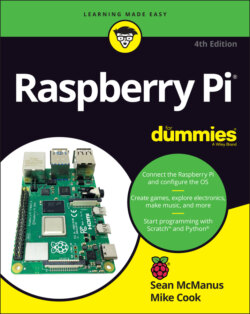Читать книгу Raspberry Pi For Dummies - McManus Sean, Evans Jonathan, Sean McManus - Страница 17
Older models
ОглавлениеOf course, the older Raspberry Pis are still out there. Recent models usually remain in production while there is demand, and you can buy secondhand versions online from websites such as eBay. Generally speaking, the newer the model, the faster its performance. Memory upgrades have made a difference, as well as the use of more powerful processors, as the Pi has evolved. There are plenty of uses for the Pi that don’t need especially fast performance, though, so you might find that an older Pi is perfect for your project. If you want to support the Raspberry Pi Foundation while buying cheaper, secondhand boards, you can donate to the foundation online.
The older models are described in this list:
Raspberry Pi 1 Model B with 256MB memory: Although it’s called Model B, this was the first Raspberry Pi to be released, in February 2012. The Raspberry Pi Model B features an Ethernet connection for the Internet and two USB ports. It uses an SD card for storage.
Raspberry Pi 1 Model B with 512MB memory: Released in October 2012, the Raspberry Pi Model B had twice the memory capacity. This improved the speed of some software, especially applications that used images heavily.
Raspberry Pi 1 Model A: The Model A, released in February 2013, is a stripped-down version of the Model B. It has just one USB port and doesn’t have an Ethernet port for connecting to the Internet. It has 256MB of memory.
Raspberry Pi 1 Model B+: The Model B+, released in July 2014, has been described by the Raspberry Pi Foundation as “the final evolution of the original Raspberry Pi.” It runs all the same software as the previous versions of the Raspberry Pi, but it has four USB ports, more GPIO pins for connecting electronics projects to the Pi, and lower power consumption and better audio than the Model B. In common with the Model B, it has 512MB of memory. Although all previous versions use SD cards for data storage, the Model B+ introduced the smaller microSD cards, which are now standard on the Raspberry Pi.
Raspberry Pi 2 Model B: Launched in February 2015, this model doubled the memory on the Model B+ to 1GB. It increased performance, compared to the Model B+, while retaining its physical features. Over the years the Pi’s performance has been improved through new software releases as well as updates to the hardware. The Pi 2 represents an immediately noticeable speed-up, compared to the Model B+.
Raspberry Pi 3 Model B: Launched in February 2016, this model has a new 64-bit processor, which means it can handle data in bigger chunks than the previous 32-bit processor. The Raspberry Pi 3 Model B is 50 percent to 60 percent faster than the Raspberry Pi 2 Model B when working in 32-bit mode.
Raspberry Pi 3 Model B+: Launched in March 2018, this model has a faster processor and improved networking speeds. It introduced support for PoE, which enables the Raspberry Pi to be powered through the Ethernet cable. You’ll need to add the Raspberry Pi PoE HAT accessory.
If you’re using anything earlier than the Model B+, you’ll need full-size SD cards (not microSD) for storage, and you’ll only have 26 GPIO pins to play with. Current add-ons are unlikely to be compatible with the early boards, so check their requirements before you buy.
Many of the projects in this book will work on older Raspberry Pi models (indeed, they first appeared in previous editions of this book when those models were the latest thing). But for best performance, we recommend using a current model, if possible.
